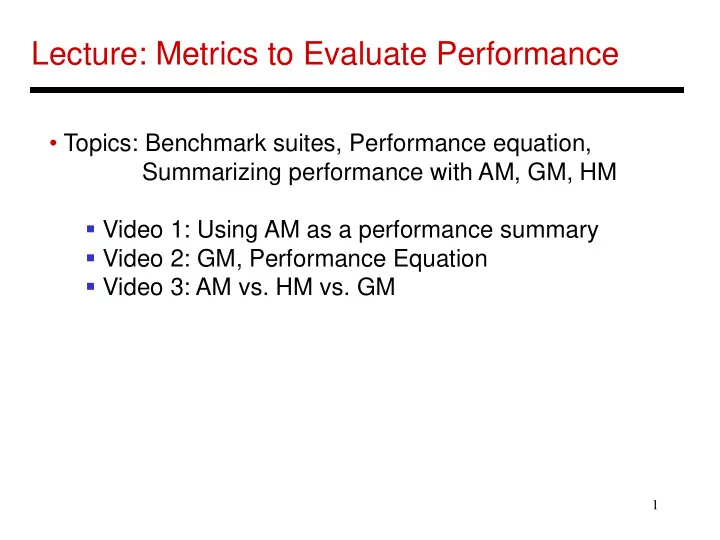

Lecture: Metrics to Evaluate Performance • Topics: Benchmark suites, Performance equation, Summarizing performance with AM, GM, HM Video 1: Using AM as a performance summary Video 2: GM, Performance Equation Video 3: AM vs. HM vs. GM 1
Measuring Performance • Two primary metrics: wall clock time (response time for a program) and throughput (jobs performed in unit time) • To optimize throughput, must ensure that there is minimal waste of resources 2
Benchmark Suites • Performance is measured with benchmark suites: a collection of programs that are likely relevant to the user SPEC CPU 2006: cpu-oriented programs (for desktops) SPECweb, TPC: throughput-oriented (for servers) EEMBC: for embedded processors/workloads 3
Summarizing Performance • Consider 25 programs from a benchmark set – how do we capture the behavior of all 25 programs with a single number? P1 P2 P3 Sys-A 10 8 25 Sys-B 12 9 20 Sys-C 8 8 30 Sum of execution times (AM) Sum of weighted execution times (AM) Geometric mean of execution times (GM) 4
Sum of Weighted Exec Times – Example • We fixed a reference machine X and ran 4 programs A, B, C, D on it such that each program ran for 1 second • The exact same workload (the four programs execute the same number of instructions that they did on machine X) is run on a new machine Y and the execution times for each program are 0.8, 1.1, 0.5, 2 • With AM of normalized execution times, we can conclude that Y is 1.1 times slower than X – perhaps, not for all workloads, but definitely for one specific workload (where all programs run on the ref-machine for an equal #cycles) 5
Summarizing Performance • Consider 25 programs from a benchmark set – how do we capture the behavior of all 25 programs with a single number? P1 P2 P3 Sys-A 10 8 25 Sys-B 12 9 20 Sys-C 8 8 30 Sum of execution times (AM) Sum of weighted execution times (AM) Geometric mean of execution times (GM) (may find inconsistencies here) 6
GM Example Computer-A Computer-B Computer-C P1 1 sec 10 secs 20 secs P2 1000 secs 100 secs 20 secs Conclusion with GMs: (i) A=B (ii) C is ~1.6 times faster • For (i) to be true, P1 must occur 100 times for every occurrence of P2 • With the above assumption, (ii) is no longer true Hence, GM can lead to inconsistencies 7
Summarizing Performance • GM: does not require a reference machine, but does not predict performance very well So we multiplied execution times and determined that sys- A is 1.2x faster…but on what workload? • AM: does predict performance for a specific workload, but that workload was determined by executing programs on a reference machine Every year or so, the reference machine will have to be updated 8
CPU Performance Equation • Clock cycle time = 1 / clock speed • CPU time = clock cycle time x cycles per instruction x number of instructions • Influencing factors for each: clock cycle time: technology and pipeline CPI: architecture and instruction set design instruction count: instruction set design and compiler • CPI (cycles per instruction) or IPC (instructions per cycle) can not be accurately estimated analytically 9
An Alternative Perspective - I • Each program is assumed to run for an equal number of cycles, so we’re fair to each program • The number of instructions executed per cycle is a measure of how well a program is doing on a system • The appropriate summary measure is sum of IPCs or AM of IPCs = 1.2 instr + 1.8 instr + 0.5 instr cyc cyc cyc • This measure implicitly assumes that 1 instr in prog-A has the same importance as 1 instr in prog-B 10
An Alternative Perspective - II • Each program is assumed to run for an equal number of instructions, so we’re fair to each program • The number of cycles required per instruction is a measure of how well a program is doing on a system • The appropriate summary measure is sum of CPIs or AM of CPIs = 0.8 cyc + 0.6 cyc + 2.0 cyc instr instr instr • This measure implicitly assumes that 1 instr in prog-A has the same importance as 1 instr in prog-B 11
AM and HM • Note that AM of IPCs = 1 / HM of CPIs and AM of CPIs = 1 / HM of IPCs • So if the programs in a benchmark suite are weighted such that each runs for an equal number of cycles, then AM of IPCs or HM of CPIs are both appropriate measures • If the programs in a benchmark suite are weighted such that each runs for an equal number of instructions, then AM of CPIs or HM of IPCs are both appropriate measures 12
AM vs. GM • GM of IPCs = 1 / GM of CPIs • AM of IPCs represents thruput for a workload where each program runs sequentially for 1 cycle each; but high-IPC programs contribute more to the AM • GM of IPCs does not represent run-time for any real workload (what does it mean to multiply instructions?); but every program’s IPC contributes equally to the final measure 13
Speedup Vs. Percentage • “Speedup” is a ratio = old exec time / new exec time • “Improvement”, “Increase”, “Decrease” usually refer to percentage relative to the baseline = (new perf – old perf) / old perf • A program ran in 100 seconds on my old laptop and in 70 seconds on my new laptop What is the speedup? What is the percentage increase in performance? What is the reduction in execution time? 14
Title • Bullet 15
Recommend
More recommend